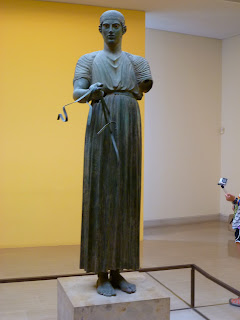The Delphic Museum and ruins of Delphi were the highlights of the day. Our tour guide spoke very clearly despite her thick Greek accent. The first sight at the museum was the statues of the two brothers. These had a strong Egyptian influence in their making. The tale goes that an old woman with twin sons wanted to visit the Oracle at Delphi. The animals pulling the cart were very slow, so the sons generously took the beasts' place to get their mother to the Oracle in time. There the mother asked Athena to give the boys the best gift for their selflessness - so Athena turned them to stone. The meaning in this tale is easily lost in American understanding. The sense of escape from pain and preservation of their memory was the best possible gift in these twins' eyes.
Next in the museum we beheld the gold and ivory remains of statues of Apollo, Artemis (his twin sister), and their mother.
Next was a sphinx - created much later than the Egyptian sphinx, and female this time.
We also saw a frieze of the battle between the gods and the titans, and another frieze of a war amongst the gods themselves.
The next item was a very rare piece - a slab of stone with ancient Greek music engraved on it. The legend of Pan is related to this as Pan (a minor god who was 1/2 goat and 1/2 man and very ugly) was very skilled at playing his panpipe. As the Oracle at Delphi resides in the temple of Apollo, the god of music, Pan was present at a festival. He was playing very skilfully and so all the people were looking for the source of the music. One they discovered him and saw his ugly face, they were panicked because he was so hideous and ran way. Another item of interest is the naval of the world - an egg shaped stone with engravings said to absorb knowledge and transfer it to the Oracle. It was believed to have been dropped by Apollo to give his Oracle more power should she need it. The legend of Apollo is an interesting one - the original god of the area was Gaia, but Apollo slew Python, the son and protector of Gaia, and so worship switched to him. Apollo felt guilty for taking a son from his mother, so as a way of apologizing, Apollo made his oracle a woman. The last item of interest at the museum was "the charioteer."
This was a rare piece because it is only one of the few surviving bronze statues from Delphi. Nero, in his reign of madness, had taken 500 other statues and melted them down for other purposes.
Next came the archaeological site. There we saw the reconstructed building of a treasury, the remains of the Temple of Apollo, another theatre, another stadium (this time with stone seats!), and the Sanctuary of Athena. It was very exciting yet exhausting as Delphi is built on a hill, but definitely worth the time and effort. It's just so amazing to see things that are even over 6000 years old and to see how people lived in that time and place.
~Ben Rinne
Next in the museum we beheld the gold and ivory remains of statues of Apollo, Artemis (his twin sister), and their mother.
Next was a sphinx - created much later than the Egyptian sphinx, and female this time.
We also saw a frieze of the battle between the gods and the titans, and another frieze of a war amongst the gods themselves.
The next item was a very rare piece - a slab of stone with ancient Greek music engraved on it. The legend of Pan is related to this as Pan (a minor god who was 1/2 goat and 1/2 man and very ugly) was very skilled at playing his panpipe. As the Oracle at Delphi resides in the temple of Apollo, the god of music, Pan was present at a festival. He was playing very skilfully and so all the people were looking for the source of the music. One they discovered him and saw his ugly face, they were panicked because he was so hideous and ran way. Another item of interest is the naval of the world - an egg shaped stone with engravings said to absorb knowledge and transfer it to the Oracle. It was believed to have been dropped by Apollo to give his Oracle more power should she need it. The legend of Apollo is an interesting one - the original god of the area was Gaia, but Apollo slew Python, the son and protector of Gaia, and so worship switched to him. Apollo felt guilty for taking a son from his mother, so as a way of apologizing, Apollo made his oracle a woman. The last item of interest at the museum was "the charioteer."
This was a rare piece because it is only one of the few surviving bronze statues from Delphi. Nero, in his reign of madness, had taken 500 other statues and melted them down for other purposes.
Next came the archaeological site. There we saw the reconstructed building of a treasury, the remains of the Temple of Apollo, another theatre, another stadium (this time with stone seats!), and the Sanctuary of Athena. It was very exciting yet exhausting as Delphi is built on a hill, but definitely worth the time and effort. It's just so amazing to see things that are even over 6000 years old and to see how people lived in that time and place.
~Ben Rinne









No comments:
Post a Comment